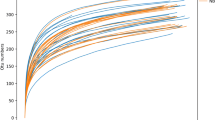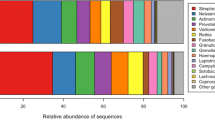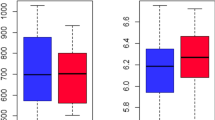Abstract
Dental caries is one of the most prevalent childhood diseases worldwide, but little is known about the dynamic characteristics of oral microbiota in the development of dental caries. To investigate the shifting bacterial profiles in different caries states, 60 children (3–7-year-old) were enrolled in this study, including 30 caries-free subjects and 30 caries-active subjects. Supragingival plaques were collected from caries-active subjects on intact enamel, white spot lesions and carious dentin lesions. Plaques from caries-free subjects were used as a control. All samples were analyzed by 454 pyrosequencing based on 16S rRNA gene V1-V3 hypervariable regions. A total of 572,773 pyrosequencing reads passed the quality control and 25,444 unique phylotypes were identified, which represented 18 phyla and 145 genera. Reduced bacterial diversity in the cavitated dentin was observed as compared with the other groups. Thirteen genera (including Capnocytophaga, Fusobacterium, Porphyromonas, Abiotrophia, Comamonas, Tannerella, Eikenella, Paludibacter, Treponema, Actinobaculum, Stenotrophomonas, Aestuariimicrobium, and Peptococcus) were found to be associated with dental health, and the bacterial profiles differed considerably depending on caries status. Eight genera (including Cryptobacterium, Lactobacillus, Megasphaera, Olsenella, Scardovia, Shuttleworthia, Cryptobacterium, and Streptococcus) were increased significantly in cavitated dentin lesions, and Actinomyces and Corynebacterium were present at significant high levels in white spot lesions (P < 0.05), while Flavobacterium, Neisseria, Bergeyella, and Derxia were enriched in the intact surfaces of caries individuals (P < 0.05). Our results showed that oral bacteria were specific at different stages of caries progression, which contributes to informing the prevention and treatment of childhood dental caries.



Similar content being viewed by others
References
Hu DY, Hong X, Li X (2011) Oral health in China—trends and challenges. Int J Oral Sci 3:7–12
Wade WG (2013) The oral microbiome in health and disease. Pharmacol Res Off J Ital Pharmacol Soc 69:137–143
Sánchez M, Llama-Palacios A, Blanc V, Leon R, Herrera D, Sanz M (2011) Structure, viability and bacterial kinetics of an in vitro biofilm model using six bacteria from the subgingival microbiota. J Periodontal Res 46:252–260
Loesche WJ (1986) Role of streptococcus mutans in human dental decay. Microbiol Rev 50:353–380
Marsh PD (2006) Dental plaque as a biofilm and a microbial community—implications for health and disease. BMC Oral Health 6(Suppl 1):S14
Marsh PD (2003) Are dental diseases examples of ecological catastrophes? Microbiology-Sgm 149:279–294
Beighton D (2005) The complex oral microflora of high-risk individuals and groups and its role in the caries process. Community Dent Oral Epidemiol 33:248–255
Yang F, Zeng XW, Ning K, Liu KL, Lo CC, Wang W, Chen J, Wang DM, Huang RR, Chang XZ, Chain PS, Xie G, Ling JQ, Xu J (2012) Saliva microbiomes distinguish caries-active from healthy human populations. ISME J 6:1–10
Takahashi N, Nyvad B (2011) The role of bacteria in the caries process: ecological perspectives. J Dent Res 90:294–303
Crielaard W, Zaura E, Schuller AA, Huse SM, Montijn RC, Keijser BJ (2011) Exploring the oral microbiota of children at various developmental stages of their dentition in the relation to their oral health. BMC Med Genom 4:22
Becker MR, Paster BJ, Leys EJ, Moeschberger ML, Kenyon SG, Galvin JL, Boches SK, Dewhirst FE, Griffen AL (2002) Molecular analysis of bacterial species associated with childhood caries. J Clin Microbiol 40:1001–1009
Luo A, Yang D, Xin B, Paster B, Qin J (2012) Microbial profiles in saliva from children with and without caries in mixed dentition. Oral Dis 6:595–601. doi:10.1111/j.1601-0825.2012.01915.x
Palmer CA, Kent R Jr, Loo CY, Hughes CV, Stutius E, Pradhan N, Dahlan M, Kanasi E, Arevalo Vasquez SS, Tanner AC (2010) Diet and caries-associated bacteria in severe early childhood caries. J Dent Res 89:1224–1229
Ling Z, Kong J, Jia P, Wei C, Wang Y, Pan Z, Huang W, Li L, Chen H, Xiang C (2010) Analysis of oral microbiota in children with dental caries by PCR-DGGE and barcoded pyrosequencing. Microb Ecol 60:677–690
Aas JA, Paster BJ, Stokes LN, Olsen I, Dewhirst FE (2005) Defining the normal bacterial flora of the oral cavity. J Clin Microbiol 43:5721–5732
Lazarevic V, Whiteson K, Huse S, Hernandez D, Farinelli L, Osteras M, Schrenzel J, Francois P (2009) Metagenomic study of the oral microbiota by Illumina high-throughput sequencing. J Microbiol Methods 79:266–271
Xie G, Chain PS, Lo CC, Liu KL, Gans J, Merritt J, Qi F (2010) Community and gene composition of a human dental plaque microbiota obtained by metagenomic sequencing. Mol Oral Microbiol 25:391–405
Parameswaran P, Jalili R, Tao L, Shokralla S, Gharizadeh B, Ronaghi M, Fire AZ (2007) A pyrosequencing-tailored nucleotide barcode design unveils opportunities for large-scale sample multiplexing. Nucleic Acids Res 35:e130. doi:10.1093/nar/gkm760
Irigoyen M, Sánchez-Hinojosa G (2000) Changes in dental caries prevalence in 12-year-old students in the state of Mexico after 9 years of salt fluoridation. Caries Res 34:303–307
Ling Z, Liu X, Wang Y, Li L, Xiang C (2013) Pyrosequencing analysis of the salivary microbiota of healthy chinese children and adults. Microb Ecol 65:487–495. doi:10.1007/s00248-012-0123-x
Quince C, Lanzen A, Davenport RJ, Turnbaugh PJ (2011) Removing noise from pyrosequenced amplicons. BMC Bioinforma 12:38
Haas BJ, Gevers D, Earl AM, Feldgarden M, Ward DV, Giannoukos G, Ciulla D, Tabbaa D, Highlander SK, Sodergren E (2011) Chimeric 16S rRNA sequence formation and detection in Sanger and 454-pyrosequenced PCR amplicons. Genome Res 21:494–504
Pruesse E, Quast C, Knittel K, Fuchs BM, Ludwig W, Peplies J, Glockner FO (2007) SILVA: a comprehensive online resource for quality checked and aligned ribosomal RNA sequence data compatible with ARB. Nucleic Acids Res 35:7188–7196
Chao A, Lee S, Jeng S (1992) Estimating population size for capture-recapture data when capture probabilities vary by time and individual, animal. Biometrics 48: 201–216
Chao A, Bunge J (2004) Estimating the number of species in a stochastic abundance model. Biometrics 58:531–539
Schloss PD, Westcott SL, Ryabin T, Hall JR, Hartmann M, Hollister EB, Lesniewski RA, Oakley BB, Parks DH, Robinson CJ (2009) Introducing mothur: open-source, platform-independent, community-supported software for describing and comparing microbial communities. Appl Environ Microbiol 75:7537–7541
Corby PM, Lyons-Weiler J, Bretz WA, Hart TC, Aas JA, Boumenna T, Goss J, Corby AL, Junior HM, Weyant RJ, Paster BJ (2005) Microbial risk indicators of early childhood caries. J Clin Microbiol 43:5753–5759
Kanasi E, Johansson I, Lu SC, Kressin NR, Nunn ME, Kent R Jr, Tanner AC (2010) Microbial risk markers for childhood caries in pediatricians' offices. J Dent Res 89:378–383
Keijser BJ, Zaura E, Huse SM, van der Vossen JM, Schuren FH, Montijn RC, ten Cate JM, Crielaard W (2008) Pyrosequencing analysis of the oral microflora of healthy adults. J Dent Res 87:1016–1020
Petrosino JF, Highlander S, Luna RA, Gibbs RA, Versalovic J (2009) Metagenomic pyrosequencing and microbial identification. Clin Chem 55:856–866
Takahashi N, Nyvad B (2008) Caries ecology revisited: microbial dynamics and the caries process. Caries Res 42:409–418
Li Y, Ge Y, Saxena D, Caufield P (2007) Genetic profiling of the oral microbiota associated with severe early-childhood caries. J Clin Microbiol 45:81–87
Kanasi E, Dewhirst FE, Chalmers NI, Kent R Jr, Moore A, Hughes CV, Pradhan N, Loo CY, Tanner AC (2010) Clonal analysis of the microbiota of severe early childhood caries. Caries Res 44:485–497
Corby PM, Bretz WA, Hart TC, Schork NJ, Wessel J, Lyons-Weiler J, Paster BJ (2007) Heritability of oral microbial species in caries-active and caries-free twins. Twin Res Hum Genet 10:821–828
Gross EL, Leys EJ, Gasparovich SR, Firestone ND, Schwartzbaum JA, Janies DA, Asnani K, Griffen AL (2010) Bacterial 16S sequence analysis of severe caries in young permanent teeth. J Clin Microbiol 48:4121–4128
Kolenbrandfr PE, Andersen RN (1984) Proceedings cell to cell interactions of capnocytophaga and bacteroides species with other oral bacteria and their potential role in development of plaque. J Periodontal Res 19:564–569
Baruque-Ramos J, Hiss H, Converti A, Gonçalves VM, Raw I (2006) Accumulation of organic acids in cultivations of Neisseria meningitidis C. J Ind Microbiol Biotechnol 33:869–877
Hoshino E, Araya A (1980) Lactate degradation by polysaccharide-producing <i> Neisseria </i> isolated from human dental plaque. Arch Oral Biol 25:211–212
Cisar J, Kolenbrander P, McIntire F (1979) Specificity of coaggregation reactions between human oral streptococci and strains of Actinomyces viscosus or Actinomyces naeslundii. Infect Immun 24:742–752
Shen S, Samaranayake LP, Yip HK (2005) Coaggregation profiles of the microflora from root surface caries lesions. Arch Oral Biol 50:23–32. doi:10.1016/j.archoralbio.2004.07.002
Hogg SD (1992) Lactic acid bacteria: volume 1—the lactic acid bacteria in health and disease, vol 1. Elsevier Applied Science, London
Warren JJ, Weber-Gasparoni K, Marshall TA, Drake DR, Dehkordi-Vakil F, Dawson DV, Tharp KM (2009) A longitudinal study of dental caries risk among very young low SES children. Community Dent Oral Epidemiol 37:116–122
Hughes CV, Dahlan M, Papadopolou E, Loo CY, Pradhan NS, Lu SC, Mathney JM, Bravoco A, Kent RL Jr, Tanner AC (2012) Aciduric microbiota and mutans streptococci in severe and recurrent severe early childhood caries. Pediatr Dent 34:e16–e23
Mitchell SC, Ruby JD, Moser S, Momeni S, Smith A, Osgood R, Litaker M, Childers N (2009) Maternal transmission of mutans Streptococci in severe-early childhood caries. Pediatr Dent 31:193–201
Byun R, Nadkarni MA, Chhour KL, Martin FE, Jacques NA, Hunter N (2004) Quantitative analysis of diverse Lactobacillus species present in advanced dental caries. J Clin Microbiol 42:3128–3136
Kraatz M, Wallace RJ, Svensson L (2011) Olsenella umbonata sp. nov., a microaerotolerant anaerobic lactic acid bacterium from the sheep rumen and pig jejunum, and emended descriptions of Olsenella, Olsenella uli and Olsenella profusa. Int J Syst Evol Microbiol 61:795–803
Munson MA, Banerjee A, Watson TF, Wade WG (2004) Molecular analysis of the microflora associated with dental caries. J Clin Microbiol 42:3023–3029
Lima KC, Coelho LT, Pinheiro IV, Rocas IN, Siqueira JF Jr (2011) Microbiota of dentinal caries as assessed by reverse-capture checkerboard analysis. Caries Res 45:21–30
Mantzourani M, Gilbert SC, Sulong HN, Sheehy EC, Tank S, Fenlon M, Beighton D (2009) The isolation of bifidobacteria from occlusal carious lesions in children and adults. Caries Res 43:308–313
Tanner AC, Mathney JM, Kent RL, Chalmers NI, Hughes CV, Loo CY, Pradhan N, Kanasi E, Hwang J, Dahlan MA, Papadopolou E, Dewhirst FE (2011) Cultivable anaerobic microbiota of severe early childhood caries. J Clin Microbiol 49:1464–1474
Aas JA, Griffen AL, Dardis SR, Lee AM, Olsen I, Dewhirst FE, Leys EJ, Paster BJ (2008) Bacteria of dental caries in primary and permanent teeth in children and young adults. J Clin Microbiol 46:1407–1417
Preza D, Olsen I, Aas JA, Willumsen T, Grinde B, Paster BJ (2008) Bacterial profiles of root caries in elderly patients. J Clin Microbiol 46:2015–2021
Torlakovic L, Klepac-Ceraj V, Ogaard B, Cotton SL, Paster BJ, Olsen I (2012) Microbial community succession on developing lesions on human enamel. J Oral Microbiol 4:10
Andersson AF, Lindberg M, Jakobsson H, Bäckhed F, Nyrén P, Engstrand L (2008) Comparative analysis of human gut microbiota by barcoded pyrosequencing. PLoS ONE 3:e283
Acknowledgments
We acknowledge Dr. Jinhua Fang and colleagues from the Affiliated Hospital of Stomatology, Zhejiang University, for their clinical assistance. The study was funded by grants from the National Natural Science Foundation of China 81371142, the Science and Technology Department of Zhejiang Province Y201225955, the Medical Technology of Zhejiang Province 2012ZDA032, the National Basic Research Program of China (973 program) 2013CB531404 and the 2011 China State key clinical department.
Author information
Authors and Affiliations
Corresponding authors
Additional information
Wen Jiang and Zongxin Ling contributed equally to this work.
Electronic supplementary material
Below is the link to the electronic supplementary material.
ESM 1
(DOC 32 kb)
ESM 2
(DOC 31 kb)
ESM 3
(DOC 31 kb)
Fig. S1
PCA plot based on weight UniFrac distance metric. Each symbol represented a sample. (JPEG 25 kb)
Fig. S2
Rarefaction curves were used to estimate richness at 3 % dissimilarity level of four groups. The vertical axis shows the number of OTUs that would be expected to be found after sampling the number of tags sequences shown on the horizontal axis. (JPEG 15 kb)
Rights and permissions
About this article
Cite this article
Jiang, W., Ling, Z., Lin, X. et al. Pyrosequencing Analysis of Oral Microbiota Shifting in Various Caries States in Childhood. Microb Ecol 67, 962–969 (2014). https://doi.org/10.1007/s00248-014-0372-y
Received:
Accepted:
Published:
Issue Date:
DOI: https://doi.org/10.1007/s00248-014-0372-y




